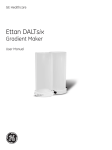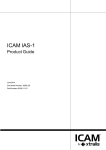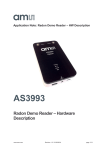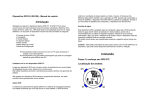Download sg series.qxp
Transcript
user manual vertical electrophoresis SG Series SG 15, SG 30, SG 50 and SG 100 Gradient Makers um 80-6457-72/Rev. BO/04-00 Page finder Introduction ........................................................................................................ Generating linear gradients .................................................................................. Generating convex and concave exponential gradients Care and maintenance 1 2 ............................................ 4 ......................................................................................... 5 Ordering information . . . . . . . . . . . . . . . . . . . . . . . . . . . . . . . . . . . . . . . . . . . . . . . . . . . . . . . . . . . . . . . . . . . . . . . . . . . . . . . . . . . . . . . . . . . .6 Technical service and repair ................................................................................ 6 Important repacking instructions . . . . . . . . . . . . . . . . . . . . . . . . . . . . . . . . . . . . . . . . . . . . . . . . . . . . . . . . . . . . . . . . . . . . . . . . . . .6 • pi um 80-6457-72 • pii • sg series instructions SG series instructions: SG 15, SG 30, SG 50, and SG 100 gradient makers The Hoefer™ SG series gradient formers are designed for producing linear gradients of aqueous solutions ranging in volume from 15–100 ml. The SG 50 and SG 100 units can be used to form convex and concave exponential gradients with the addition of an exponential gradient plunger accessory. The small units (SG 15, SG 30, SG 50, and SG 100) are machined from solid blocks of acrylic plastic. They are suitable for casting acrylamide pore gradient gels, casting immobilized pH gradient gels, pouring density gradients for centrifugal sedimentation separations and delivering salt gradients for low pressure chromatography systems. reservoir (back) chamber plunger vent connector channel mixing (front) chamber plunger body plunger o-ring stopcock nut stopcock washer connector stopcock delivery stopcock outlet connector (4 mm id tubing) Fig 1. SG series gradient former and exponential plunger. • p1 sg series • generating linear gradients 1. Generating linear gradients To generate a linear gradient between two concentrations, equal volumes of solutions of the two concentrations are measured into the two chambers of the gradient former. As solution is delivered out of the mixing chamber, an equal volume flows in from the reservoir chamber where it is rapidly diluted and mixed to uniformity. The initial concentration delivered will be that of the solution in the mixing chamber, the final concentration will be that of the reservoir chamber. For the most consistent delivery of gradients, a peristaltic pump is recommended. Table 1. Operating ranges for linear gradients Model max total vol (ml) min vol/chamber (ml) max stir bar length (mm) SG 15 15 3 12 SG 30 30 5 15 SG 50 50 8 15 SG 100 100 16 20 1. Make sure all parts are clean and liquid flows freely through all channels, stopcocks and tubing. 2. Add a magnetic stir bar of the appropriate dimensions to the mixing chamber (Table 1) and place the unit on a magnetic stirrer. If volumes will be less than half the capacity of the unit, an identical stir bar should be placed in the reservoir chamber as well to balance the displacement and prevent backflow into the reservoir when the chambers are first connected. Connect tubing to the outlet connector and pump, and adjust pump speed, if used. Position or connect the tubing to the receiving vessel (gel casting unit, centrifuge tube, etc.) 3. Close both stopcocks (handles up) and add the required volume of the final solution to the reservoir (back) chamber. 4. Carefully open the connector stopcock and allow just enough solution to flow through the connector channel to fill it to the edge of the mixing chamber, then close the stopcock. Be sure no large bubbles remain to obstruct flow through the channel. 5. Add the required volume of the starting solution to the mixing chamber and start the magnetic stirrer. 6. Open the delivery stopcock. 7. Simultaneously open the connector stopcock and start the pump. Note: if there is a substantial difference in densities between the two solutions, there will be a sudden flow from the denser chamber to the lighter chamber to bring the two into hydrostatic balance. This will result in the gradient not being fully linear. To avoid this, add equal weights, rather than volumes, of the solutions to the appropriate chambers. 8. If it is important that no bubbles disturb the gradient, watch the delivery carefully and as soon as the last of the solution has entered the pump head, stop the pump and remove the tubing from the receiving container. 9. Flush and rinse all parts thoroughly with distilled water after use. um 80-6457-72 • p2 • pouring gradients 1.1 Pouring gradients from the top Filling a container with a gradient (e.g. casting acrylamide pore gradient gels) can be done either dense solution first (“from the top”), or light solution first (“from the bottom”). To fill from the top: 1. Proceed as described above, putting light (final or top) solution in the reservoir chamber (step 3) and dense solution in the mixing chamber (step 5). 2. Place the delivery outlet against the upper edge of the receiving container. Adjust the pump rate so that the solution flows evenly down the side in a smooth, continuous stream. The delivery speed should be slow enough that the newly arriving solution does not mix with the underlying solution. Alternatively, using a rigid cannula at the end of the delivery tubing, hold the tip of the cannula just above the surface of the solution, raising it smoothly as the container fills. 1.2 Pouring gradients from the bottom This technique is commonly used in filling multiple gel casting chambers. 1. Proceed as described above, putting dense (final or bottom) solution in the reservoir chamber (step 3) and light solution in the mixing chamber (step 5). 2. Connect the delivery tubing to the bottom inlet of a gel casting unit or to a cannula long enough to reach the bottom of the receiving container. Adjust the pump rate so that the solution is not forced up in a “fountain” that mixes with the overlying solution. 3. If all of the gradient solution must be delivered to the container, a displacement solution may be used. Just as the last of the gradient mix is pumped out of the mixing chamber, add an appropriate volume of a denser displacement solution to the mixing chamber and pump it through until all of the gradient mix has been delivered. It is convenient to include a dye in the displacement solution to visually track the boundary between the gradient mix and the displacement solution. • p3 sg series • generating convex and concave exponential gradients 2. Generating convex and concave exponential gradients If the volume in the mixing chamber is held constant (as opposed to declining for linear gradients), the gradient generated will have an exponential concentration curve. The mixing volume in the SG 50 and SG 100 units can be held constant by sealing the top of the mixing chamber with the exponential gradient plunger accessory. The total volume of the gradient can be greater than the maximum volume of the gradient former because additional solution can be repeatedly added to the reservoir chamber. Using Eq 1, examples of the gradients generated by various combinations of volumes and concentrations listed in Table 2 are plotted in Fig 3. Concave gradients are generated high concentration first, and thus containers such as gel cassettes must be filled from the top. Convex gradients must be filled from the bottom. Most frequently used is the concave pore gradient for increased resolution in the high molecular weight region of acrylamide gels. Eq 1 To generate an exponential gradient: 1. Make sure all parts are clean and liquid flows freely through all channels, stopcocks and tubing. 2. Attach to the red plunger vent a short piece of flexible vinyl tubing that can be clamped off to make an airtight seal. 3. Add a magnetic stir bar of the appropriate dimensions to the mixing chamber and place the unit on a magnetic stirrer. Connect tubing to the outlet connector and pump, then adjust pump speed, if needed. Position or connect the tubing to the receiving vessel (gel casting unit, centrifuge tube, etc.) at top or bottom, as appropriate. 4. Close both stopcocks (handle up) and add a portion of the final solution to the reservoir (back) chamber. 5. Carefully open the connector stopcock and allow just enough solution to flow through the connector channel to fill it to the edge of the mixing chamber, then close the stopcock. Be sure no large bubbles remain to obstruct flow through the channel. 6. Add the required volume of the starting solution to the mixing chamber. With the plunger vent open, insert the plunger into the mixing chamber and press it down until it is just above the surface of the solution (Fig 2). Clamp off the tubing on the vent airtight. 7. Start the magnetic stirrer and open the delivery stopcock. 8. Simultaneously open the connector stopcock and start the pump. Note: if the gradient volume is larger than the reservoir will hold, the additional volume can be added during the gradient delivery. Do not allow the reservoir chamber to go dry as bubbles will be pulled into the mixing chamber, changing the dilution volume and gradient shape. Fig 2. Gradient maker with plunger in place. 9. Stop the pump and remove the tubing from the receiving container as soon as the last of the solution has left the reservoir chamber. Note: The entire solution remaining in the mixing chamber is at the final concentration and does not contribute further to the gradient. If desired, it can be used as a displacement solution for convex gradients unless it contains acrylamide. 10. Disconnect tubing. Flush and rinse all parts thoroughly with distilled water after use. um 80-6457-72 • p4 • examples of concave and convex exponential gradients Table 2. Examples of concave and convex exponential gradients A B C D E 1 0 0 0.5 1 Vmix 20 20 50 20 20 Cres 0 1 1 1 0.5 Vres 100 100 10 100 100 Cmix* *c: concentration, v: volume, mix: mixing chamber, res: reservoir chamber 1.0 0.9 D 0.8 B concentration 0.7 0.6 E 0.5 0.4 0.3 A 0.2 C 0.1 0.0 0% 20% 40% 60% 80% 100% % of gradient delivered Fig 3. Examples of exponential gradients • p5 sg series • care and maintenance 3. Care and maintenance The gradient maker should be cleaned thoroughly with distilled water after use to prevent polymerization or crystallization of solutions in the chambers and stopcocks. Do not use abrasives, acetone, pure alcohols or organic solvents to clean this unit. 4. Ordering information Qty. Code No. SG 15 Gradient Maker, 15 ml total volume 1 80-6197-61 SG 30 Gradient Maker, 30 ml total volume 1 80-6197-80 SG 50 Gradient Maker, 50 ml total volume 1 80-6197-99 SG 100 Gradient Maker, 100 ml total volume 1 80-6196-09 Plunger for exponential gradient, SG 50 1 80-6198-75 Plunger for exponential gradient, SG 100 1 80-6197-23 White 3-mm outlet fitting, SG 15, SG 30, SG 50, SG100 1 80-6196-85 Black Luer fitting, SG 15, SG 30, SG 50 1 80-6196-66 Stopcock, standard size, for SG 15, SG 30, SG 50 1 80-6196-28 Long stopcock, for SG 100, connector stopcock 1 80-6197-04 Short stopcock, for SG 100, delivery stopcock 1 80-6196-47 SG 500 Gradient Maker, 500 ml total volume 1 80-6198-18 5. Technical service and repair Amersham Biosciences offers complete technical support for all our products. If you have any questions about how to use this product, or would like to arrange to repair it, please call or fax your local Amersham Biosciences representative. 6. Important repacking instructions Request a copy of the Amersham Biosciences “Contamination Clearance Certificate” before returning the item. No items can be accepted for servicing or return unless this form is properly completed. um 80-6457-72 • p6 Hoefer is a trademark of Amersham Biosciences Limited or its subsidiaries. Amersham and Amersham Biosciences is a trademark of Amersham plc. © 2000 Amersham Biosciences Inc. All rights reserved. All goods and services are sold subject to the terms and conditions of sale of the company within the Amersham Biosciences group that supplies them. A copy of these terms and conditions is available on request. Printed in the USA. Amersham Biosciences UK Limited Amersham Place Little Chalfont Buckinghamshire England HP7 9NA Amersham Biosciences AB SE-751 84 Uppsala Sweden Amersham Biosciences Inc. 800 Centennial Avenue PO Box 1327 Piscataway NJ 08855 USA Amersham Biosciences Europe GmbH Munzinger Strasse 9 D-79111 Freiburg Germany www.amershambiosciences.com






















